| Pseudobranchus axanthus | |||||||||
| Southern Dwarf Siren | |||||||||
| Pseudobranchus striatus | |||||||||
| Northern Dwarf Siren | |||||||||
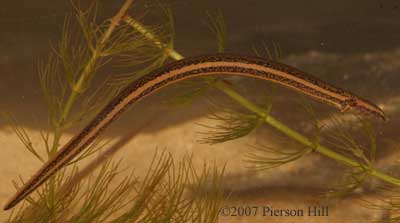
|
|
||||||||
| P. striatus spheniscus |
Species and Subspecies
P. a. axanthus Narrow-striped Dwarf Siren
Range: Peninsular Florida
First described: Netting and Goin, 1942
P. a. belli Everglades Dwarf Siren
Range: Peninsular Florida
First described: Schwartz, 1952
P. s. striatus Broad-striped Dwarf Siren
Range: Coastal plain regions of southern South Carolina, Georgia, and northern Florida
First described: LeConte, 1824
P. s. lustricolus Gulf Hammock Dwarf Siren
Range: Coastal plain regions of southern South Carolina, Georgia, and northern Florida
First described: Goin and Crenshaw, 1949
P. s. spheniscus Slender Dwarf Siren
Range: Coastal plain regions of southern South Carolina, Georgia, and northern Florida
First described: Neill, 1951
Note: The caresheet below is an exerpt of an article appearing in Issue 1 of Caudata.org Magazine (PDF).
Description
Dwarf sirens are eel-like aquatic salamanders that lack rear legs and retain external gills throughout life. In general, dwarf sirens are only found in the southeastern United States, ranging from southeastern South Carolina through the southern part of Georgia and through the majority of Florida. Narrow-striped dwarf sirens are located only in north-eastern and central Florida.
Some authors have considered all the dwarf sirens to be subspecies of a single species, P. striatus (Conant, Collins, 1991). Recent chromosomal studies have demonstrated that they are two distinct species with P. axanthus having 32 chromosomes and P. striatus having 24 chromosomes (Moler, Kezer, 1993). Due to this information, I am treating them as two different species. At this time, the biology of P. striatus is poorly understood. Husbandry requirements should be very similar for the two species, but reproductive cues may be very different.
Dwarf sirens can reach an adult size of 12-19 cm (4.75-7.5 inches) and can be distinguished from the larger species of siren by counting the toes on their feet. Greater sirens (Siren lacertina) and lesser sirens (Siren intermedia) both have four toes on each foot, while dwarf sirens only have three toes on each foot. Distinguishing between the different types of dwarf sirens may require knowing the origin of the animal as well as comparison of the color pattern to a field guide.
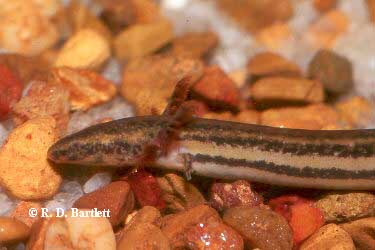 P. axanthus belli
P. axanthus belli
|
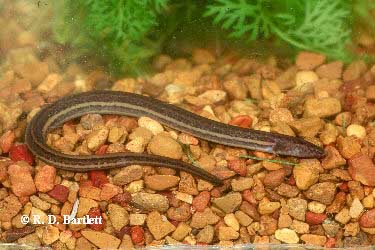 P. axanthus belli
P. axanthus belli
|
Housing
Narrow-striped dwarf sirens can be easily maintained in a filtered aquarium in a cool location. An appropriate temperature range for maintaining narrow-striped dwarf sirens is 21-27°C (70-80°F). If the temperature in the enclosure exceeds 27°C (80°F), the dwarf sirens will need to be watched for signs of thermal stress such as rigidity, and escape behavior. If these behaviors are observed, the sirens will need to be immediately moved to a cooler location.
Depending upon the number and size of the dwarf sirens, the size of the enclosure will vary. I have had considerable success keeping three to four adult dwarf sirens in a 75 L (20 US gallon) aquarium. The aquarium should have several flat stones or small pieces of PVC pipe to give the sirens shelter. The substrate in the aquarium can consist of ~2.5 cm (1 inch) of clean pea gravel. The gravel should consist of quartz or other material that won't leach minerals into the water.
In the wild, dwarf sirens inhabit shallow, still, or slow-moving waters with heavy plant cover. Planting the aquarium with floating plants and bunches of plants will help the sirens feel secure and promote more activity. The plants can be planted in a manner that is decorative, as well as making the dwarf sirens feel secure. If the dwarf sirens feel insecure they will spend the majority of the time hidden or burrowed into the substrate. Frequently the only part of the siren visible will be the tail. If the enclosure is filled close to the top with water, then a tight fitting lid is required to prevent the sirens from escaping. If there is at least 10 cm (4 inches) between the surface of the water and the top of the aquarium, then the sirens can be kept in an open top enclosure with minimal concern about escape.

P. axanthus |
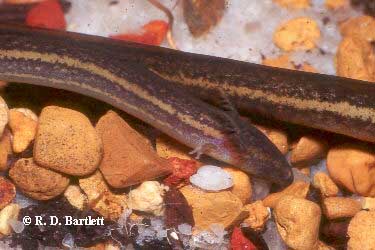
P. axanthus axanthus |
Sponge filters, canister filters and submersible filters all make excellent choices for maintaining the water quality required for dwarf sirens. Caution should be taken to make sure that the power filter's intakes are covered by a screen to prevent the dwarf sirens from being pulled in. Water quality should be maintained by regular water changes. The water changes should ideally not exceed 30% of the total water volume to prevent abrupt changes in water chemistry. When refilling the enclosure, the water should be chlorine free as well as aged for at least 24 hours. The aging process is not to remove the chlorine, but to allow excess gases to escape from the water. Water directly from the tap is often saturated with gases, and these gases can harm or stress the salamanders. Dwarf sirens that are under stress from chlorine or gas super-saturation will produce a thicker mucous layer, giving the siren a whiter appearance. If this warning sign is noted and no actions are taken to resolve the issue, death can result in less than 24 hours (personal observation). Depending on the feeding schedule and the number of the dwarf sirens maintained in the enclosure, water changes can be conducted either once a week or twice a week. Care must be taken when conducting the water changes to prevent the dwarf sirens from panicking and leaping out of the enclosure. If a dwarf siren does escape, assisting the siren into a damp net with wet hands will minimize any damage to the siren's skin. The total hardness of the water should not be allowed to exceed 200 ppm as this may cause unnecessary stress. Regular monitoring of the water quality by testing is recommended to maintain the best water quality possible. If ammonia or nitrite is detected in the water then immediate water changes should be conducted.
Unlike some of the larger sirens that regularly bite and inflict wounds on other sirens during mating or territorial displays, in my observations dwarf sirens are generally not aggressive. However, if dwarf sirens are confined together in a small container then they may damage each other's tails (Freeman, 1967).
Dwarf sirens can be kept with other amphibians and fish, provided that the other occupants of the enclosure will not attack the dwarf sirens. Other occupants that could be housed with dwarf sirens are Red-Spotted newts (such as Notophthalmus viridescens louisianensis and N. v. piaropicola), the Striped Newt (N. perstriatus; these newts will prey on the dwarf siren eggs), and any of the small Hylid tree frogs such as the Squirrel Tree Frog (Hyla squirella) or the Green Tree Frog (Hyla cinerea). Small peaceful fish that won't nip the dwarf sirens' gills, such as the Least Killifish or Pygmy Livebearer (Heterandria formosa), are an excellent choice if zoogeography is important to the herpetoculturist; otherwise White Cloud Minnows make an excellent addition.
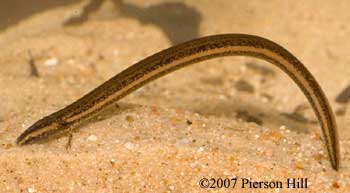 P. striatus spheniscus |
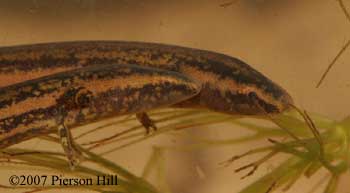
P. striatus spheniscus |
Feeding
In the wild, dwarf sirens feed on aquatic insects and worms. As the mouths of dwarf sirens are rather small, their food must be of similar size. In captivity, brine shrimp (Artremia salina), blackworms (Lumbriculus variegatus), whiteworms (Enchytraeus albigulas), redworms (or other earthworms), bloodworms, and Tubifex are appropriate. If the food has started to decompose the dwarf sirens will refuse it (Freeman; 1967). As dwarf sirens often feed at night, any frozen food should be fed as close as possible to the time at which the lights are turned off in order to prevent refusal of the food due to decomposition.
Care must be taken when feeding live Tubifex worms to the dwarf sirens to avoid introducing predatory invertebrates, as these may prey on small or immature sirens. Tubifex worms also have some additional drawbacks - they may become established in the aquarium substrate and reproduce there. While this may provide a constant supply of food to the dwarf sirens, the worms will prey upon and destroy any eggs in the enclosure (personal observation). Another problem with Tubifex is that they are collected from sewage outflow areas and may be contaminated with pathogenic bacteria.
Adults can also be fed redworms that have been sorted for size. A dwarf siren can consume redworms up to a third of its own body length (Freeman, 1967). Depending upon the size and the type of food being offered, the dwarf sirens can be fed either daily or several times a week.
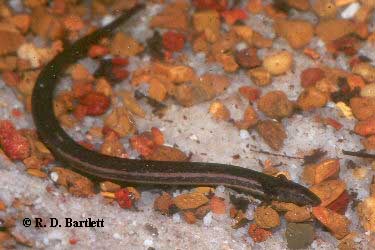
P. striatus striatus
Breeding
There are no external sex differences, so if breeding is the goal, groups need to be housed together. To induce breeding, some temperature and photoperiod fluctuations will prove beneficial. The temperature of the aquarium should be reduced slowly to 18°C (65°F). At the same time, the photoperiod should be reduced to 9-10 hours per day. After cycling the animals with these conditions for about two months, the aquarium should be warmed slowly to 22°C (72°F), while increasing the photoperiod to 11-12 hours. The sirens will spawn some time during the warming period while the lights are off (at night). The sirens may spawn for several days in a row or different females may be ready at different times so spawns can be up to several weeks apart. The eggs will be scattered about the aquarium, either singly, or in small clumps. The eggs may be attached to various items in the aquarium, or loose and unattached.
If the dwarf sirens do not spawn using the above technique, the addition of several gallons of distilled/deionised/reverse-osmosis water to the enclosure may trigger breeding and spawning, as this will simulate a decrease in water hardness due to spring rain.
As an experiment, a group of the dwarf sirens was cycled and then maintained on a 12:12 photoperiod at 22°C (72°F). The adults were fed with blackworms to satiation and a population of blackworms was maintained in the aquarium at all times. Under these conditions, spawning occurred every 3-5 weeks for over a year. During this period, portions of the courtship and spawning behaviors were observed. The male drove the female around the aquarium by nudging the female around the cloaca and vibrating his head. These behaviors continued until the female located a suitable egg deposition site. During these observations, the female deposited a single egg at a time, although the same egg deposition site was chosen several times in a row, resulting in clumps of eggs. During egg deposition, the male continued the nudging and vibrating behaviors.
After the female laid the egg, the male would locate the egg by following the female, at which time he would coil and twine around the egg, passing his cloaca over the egg several times. Presumably fertilization occurred at this time, but a quick water sample collected near the egg did not show any free-swimming sperm, although development of the embryo was detectable after several days.
While the eggs appeared to stick to the deposition site, the actions of the male, and occasionally the female, would knock the egg loose. Either the adults or the eggs should be moved to a separate aquarium to prevent the adults from cannibalizing the eggs (Petranka, 1998).
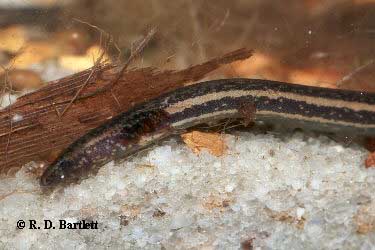
P. striatus spheniscus
Rearing offspring
At 22°C (72°F) the eggs take about 24 days to hatch. The newly hatched larvae are best housed in a bare-bottomed shoebox or small aquarium with floating plants and 7.5-10 cm (3-4 in) of water. When first moving the larvae to the shoebox, make sure that the initial set-up contains water from the hatching tank to prevent stress due to the change in the water conditions. The bare bottom will assist the larvae with locating food and allow monitoring of their feeding.
Hatchling and juvenile dwarf sirens can be reared on brine shrimp and appropriately sized whiteworms or finely chopped blackworms. Rearing dwarf sirens on a diet consisting solely of whiteworms has caused sirens to develop severe metabolic bone disease. The larval dwarf sirens should be fed daily until sated. All uneaten food should be removed after 24 hours to prevent fouling. At the same time, a small daily water change will facilitate the maintenance of excellent water quality. A piece of airline tubing will allow the siphoning of waste and uneaten food while minimizing the risk of damaging larval sirens. A small air stone or sponge filter can be added to facilitate the oxygenation of the water and the removal of ammonia.
When larval dwarf sirens are approximately 10 cm (4 inches) in length, they can be moved to an adult feeding schedule and diet. As the larvae grow, the depth of the water can be increased slowly until the conditions are the same as those in which the adults are kept. If the gills appear to be becoming larger and more branched, this may be an indication that the water quality in the enclosure has deteriorated (Wright, 1996). Water tests and changes should be undertaken immediately.
References
Roger CONANT, Joseph T. COLLINS, Reptiles and Amphibians of Eastern and Central North America, Houghton Mifflin Company, Boston, 1991.
John R. FREEMAN, Feeding behavior of the narrow-striped dwarf siren Pseudobranchus striatus axanthus, Herpetologica, 23(4):313-314, 1967.
Paul E. MOLER, James KEZER, Karyology and systemics of the salamander genus Pseudobranchus (Sirenidae), Copeia, 1:39-47, 1993.
James W. PETRANKA, Salamanders of the United States and Canada, Smithsonian Institutional Press, Washington, 1998.
Kevin M. WRIGHT, Disinfection for the Herpetoculturist, The Vivarium, 5(1):31-33, 1993.
Kevin M. WRIGHT, Amphibian husbandry and medicine, In: Reptile Medicine and Surgery, edited by Douglas W. Mader, W. Saunders Company, Philadelphia, 1996.
© 2004 Ed Kowalski.
